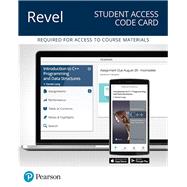For introductory courses in Computer Science and Computer Programming courses.
A fundamentals first approach to programming helps students create efficient, elegant code
Revel™ Introduction to Programming with C++ introduces students to basic programming concepts using a fundamentals-first approach that prepares them for learning object-oriented and advanced C++ programming. This approach presents programming concepts and techniques that include control statements, loops, functions, and arrays before discussing object-oriented programming. Students learn to approach programming as a method for problem solving with interesting and practical examples that illustrate syntax. The content incorporates a wide variety of problems with various levels of difficulty and covers many application areas to engage and motivate students.
Revel is Pearson’s newest way of delivering our respected content. Fully digital and highly engaging, Revel replaces the textbook and gives students everything they need for the course. Informed by extensive research on how people read, think, and learn, Revel is an interactive learning environment that enables students to read, practice, and study in one continuous experience – for less than the cost of a traditional textbook.
NOTE: Revel is a fully digital delivery of Pearson content. This ISBN is for the standalone Revel access card. In addition to this access card, you will need a course invite link, provided by your instructor, to register for and use Revel.








